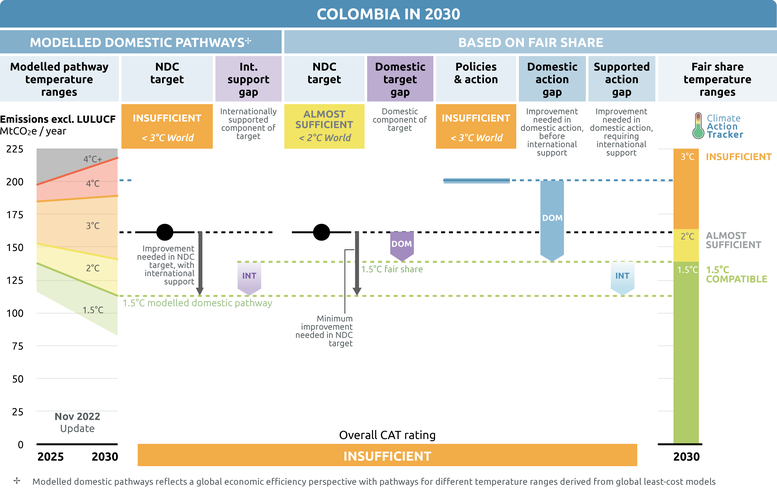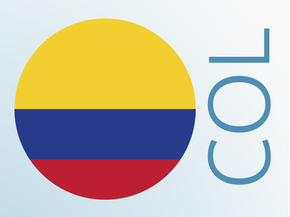Targets
Target Overview
In its updated NDC, Colombia has set an unconditional target of not exceeding 161 MCO2e (AR4) in 2030 (equivalent to a 51% reduction in emissions compared to the projection of emissions in 2030 in the reference scenario). This target covers all sectors.
CAT excludes emissions from land use, land use change and forestry from this target. For further details on the calculation, see the Assumptions section. CAT rates this target as “Insufficient” when compared to required domestic efforts, and "Almost sufficient” compared to Colombia’s fair share.
Colombia has a net zero target and has submitted a long-term strategy to the UNFCCC. Both the NDC and net zero targets are enshrined in law.
| COLOMBIA - Main climate targets |
|---|
| 2030 unconditional NDC target | |
|---|---|
| Formulation of target in NDC |
Emissions limit of 169.4 MtCO2e in 2030 (equivalent to a 51% reduction below BAU), with an emissions peak by 2027*. Carbon budgets for the period 2020-2030 will be established by 2023. |
| Absolute emissions level in 2030 excl. LULUCF |
161 MtCO2e** [64% above 1990] [8% above 2010] |
| Status | Submitted on 30 December 2020 |
| Net zero & other long-term targets | |
|---|---|
| Formulation of target | Carbon neutral by 2050 |
| Absolute emissions level in 2050 excl. LULUCF | N/A |
| Status | Submitted on 21 November 2021 |
* Colombia’s NDC reports use the GWP from AR5.
** This value was converted using GWP from AR4 and excl. LULUCF.
CAT rating of targets

The CAT rates NDC targets against what a fair contribution to achieving the Paris Agreement’s long-term temperature goal would be, as well as against what needs to happen within a country’s own borders. Colombia will need international support to achieve those needed reductions within its borders.
Colombia has one NDC target. It has not specified whether a portion of the target is conditional on international support or whether its NDC has an international element, so we rate its NDC target against both metrics.
Colombia has not put forward a target conditional on receiving international support. However, the NDC document mentions that for Colombia to be able to move towards a more ambitious NDC, with additionality and impact, the continuity of international cooperation will be key to continuing on this path in all aspects of its NDC. The CAT methodology shows that provision of international support is consistent with the wide range of literature on fair share contributions to meeting the Paris Agreement's goals.
As Colombia has not put forward a conditional target, we assess its unconditional NDC target against modelled domestic pathways, i.e. what would need to happen within Colombia’s borders to be consistent with limiting warming to 1.5°C. Against that framework, the unconditional NDC target rates it as “Insufficient”.
The “Insufficient” rating indicates that the target needs substantial improvements to be consistent with limiting warming to 1.5°C. If all countries were to follow Colombia’s approach, warming would reach over 2°C and up to 3°C.
Colombia’s rating has improved by one category, from “Highly insufficient” to “Insufficient”. The change is due to the manner in which we exclude LULUCF from the NDC, rather than any change in the target itself. In our last assessment, we indicated that there was significant uncertainty on the extent to which Colombia intends to rely on the land sector and so we developed a target range based on different approaches. Due to the further information provided in the country’s latest biennial report, we have dropped the upper end of our range (see Assumptions tab for further details).
In addition to being inconsistent with a 1.5°C pathway when compared to modelled domestic pathways, Colombia’s NDC target is also inconsistent with a 1.5°C pathway when compared to its fair share contribution.
In order to achieve its fair share contribution under the Paris Agreement, Colombia would need to reach absolute emissions of at or below 139 MtCO2e in 2030.
We estimate Colombia’s NDC target to be 161 MtCO2e by 2030 (excl. LULUCF). The CAT rates the target as “Almost sufficient”.
The “Almost sufficient” rating indicates that Colombia’s NDC target in 2030 is not yet consistent with limiting warming to 1.5°C but could be, with moderate improvements. Colombia’s target is within the range of what is considered to be a fair global effort, but would require other countries to make deeper reductions and comparably greater effort to limit warming to 1.5°C. If all countries were to follow Colombia’s approach, warming could be held below—but not well below—2°C.
Colombia’s rating has improved by one category, from “Insufficient” to “Almost sufficient”. The change is due to the manner in which we exclude LULUCF from the NDC, rather than any change in the target itself (see the Assumptions tab for further details).
Further information on how the CAT rates countries (against modelled pathways and fair share) can be found here.
NDC Updates
Colombia submitted an updated NDC in December 2020. As part of the update, Colombia increased its mitigation ambition to an absolute emissions limit of 169 MtCO2e including LULUCF in 2030 (AR5), equivalent to a 51% emissions reduction compared to a business as usual (BAU). The update is more ambitious than Colombia’s initial NDC, which pledged an unconditional emissions reduction of 20% and a conditional emissions reduction of 30% compared to BAU by 2030.
Colombia has improved the type of target—from a reduction compared to BAU—to set an absolute cap on emissions in 2030.
In addition, the commitment includes a peak in emissions by 2027. According to our projections, Colombia would need to peak GHG emissions much sooner in order to get on a pathway that would bring the 2030 NDC target within reach, let alone achieve a pathway compatible with 1.5°C temperature goal.
| COLOMBIA — History of NDC updates | 2018 NDC | 2020 NDC update |
|---|---|---|
| 1.5°C compatible |
|
|
| Stronger target | N/A |
|
| Economy-wide coverage |
|
|
| Fixed/absolute target |
|
|
| 2018 NDC | 2020 NDC update | |
|---|---|---|
| Formulation of target in NDC |
Unconditional target: Reducing emissions by 20% below BAU by 2030 (incl. LULUCF). Conditional target: Reduce emission up to 30% below BAU by 2030 (incl. LULUCF), with international support. |
Unconditional target: Emission limit of 169.44 MtCO2e * in 2030 incl. LULUCF, equivalent to a 51% reduction below BAU. |
| Absolute emissions level in 2030 excl. LULUCF |
Unconditional target: 200 MtCO2e** Conditional target: 208 MtCO2e |
Unconditional target: 161 MtCO2e |
| Emissions compared to 1990 and 2010 excl. LULUCF |
Unconditional target: 102% above 1990 emissions by 2030 37% below 2010 emissions by 2030 Conditional target: 111% above 1990 emissions by 2030 43% above 2010 emissions by 2030 |
Unconditional target: 64% above 1990 emissions by 2030 8% above 2010 emissions by 2030 |
| CAT rating |
Overall rating: N/A |
NDC target against modelled domestic pathways: Insufficient NDC target against fair share: Almost sufficient |
| Sector coverage | Economy-wide | Unchanged |
| Separate target for LULUCF | No | Unchanged |
| Gas coverage | CO2, CH4, N2O, HFCs, PFCs, and SF6 | Unchanged |
| Target type | Emissions reduction from BAU | Absolute emissions reduction (single year target) |
| Explanation why the target is a fair contribution towards the global goal | Yes, based on their energy consumption and emission profile, per capita emissions of their NDC target and consistency with a 2°C pathway, commitment to reducing deforestation and development status. | Colombia's NDC is fair in responding to the vulnerability of our territory to the impacts of climate change and puts Colombia's contribution as a middle-income developing country on the table. In this way, Colombia responds strongly to the call of science, indicated in the IPCC Report of 1.5°C (IPCC, 2019), and includes all sectors of our economy. |
| Followed guidance in Decision 4/CMA.1 on target transparency | N/A | Yes |
* Values in AR4, assumptions made to quantify these targets are included in the Assumptions section
** Before September 2021, all CAT ratings were based exclusively on fair share and only assessed a country’s target
Analysis of earlier NDC developments:
- 30.12.2020: Colombia submitted a stronger NDC target
Net zero and other long-term target(s)
Colombia has a net zero GHG emissions target by mid-century. In November 2021, Colombia submitted the National Long-Term Strategy (E2050) to the UNFCCC. The Strategy includes different scenarios and pathways and outlines nine strategic initiatives with 48 transformation options to be considered by decision-makers.
In December 2021, with the Law No. 2169 (Ley Climatica N°2169, 2021), Colombia promotes the country's low-carbon development through the establishment of minimum targets and measures for carbon neutrality and climate resilience. This enriches the carbon neutrality target into law.
The strategy describes the need to carry out mitigation actions in all sectors, intending to reduce GHG emissions by 90%. A reduction of the remaining 10% of emissions will be achieved through land or carbon capture technology to reach net zero.
We evaluate Colombia’s net zero target as “acceptable”.
The full net zero target analysis can be found here.
2020 pledge
Colombia did not submit concrete emission reduction targets for 2020 under the Copenhagen Accord. Instead it set a unilateral target to achieve 77% of its electricity generation from renewable sources by 2020 along with two targets dependent on financial support from Annex I parties: zero deforestation in the Colombian Amazon and a share or 20% biofuels in the country’s total liquid fuel use by 2020 (Bermúdez Merizalde, 2010).
Further analysis
Country-related publications
Stay informed
Subscribe to our newsletter
